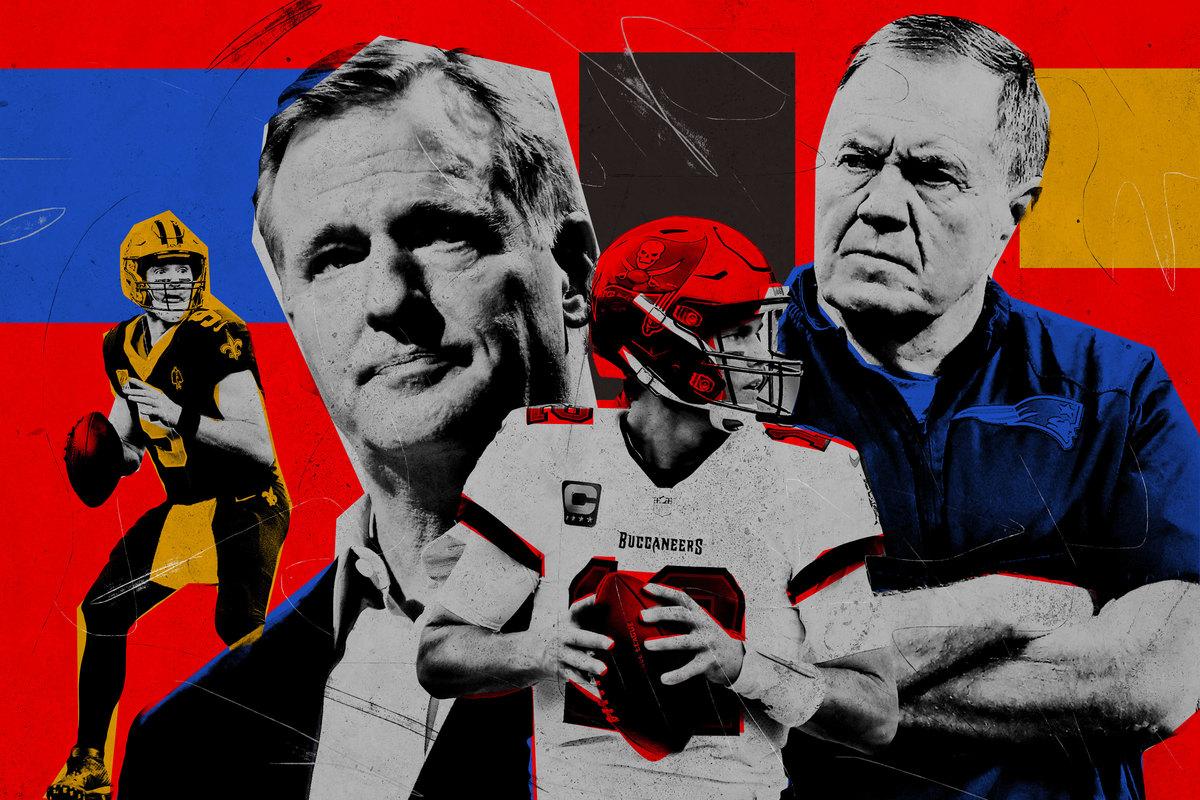The Patriots’ 30-27 win over the Jets on Monday Night Football was the 133rd game of the 2020 season, meaning the NFL is more than halfway through its regular season. What began as a season of uncertainty in many ways remains one. COVID-19 cases are rising throughout the country. The NFL and NFLPA reported 25 positive test results for players and personnel between October 25 and 31. That’s the second-highest number of positives since the league began reporting weekly figures at the start of the season—26 positives were reported in early October when the Titans had an outbreak in their facility. Several games were rescheduled after the Titans’ positive tests, but with just 10 of the 32 bye week slots remaining on the schedule, there’s limited flexibility to accommodate further changes. NFL owners will vote Tuesday on a playoff contingency plan that would allow additional teams to make the playoffs if games need to be canceled and teams cannot complete 16 regular-season games.
As for what’s happening on the field, we’ve seen offenses thrive, rookie quarterbacks produce ahead of schedule, and the Jets continue to be the Jets. With Week 9 in the books and the playoff picture starting to take shape, here are the most pressing questions for the second half of the season.
Will scoring stay up?
Through eight weeks, the NFL was on pace for more points (5,996) and more touchdowns (692) than any season since the 1970 merger. On a macro level, a new group of athletic, young quarterbacks paired with smart play-callers are infusing the league with more offense, but there are a few microtrends that also explain the scoring boom. Holding calls are down—there have been 1.7 holding calls per game so far this year, down from 2.7 per game last season—which keeps offenses in good down and distances. Coaches have also been more aggressive. As of October 6, coaches were going for it on fourth downs more than any time in the past 10 years, according to NFL data and analytics director Michael Lopez. Defenses have not been able to get off the field. Before this season, the 1995 Cleveland Browns had the worst third-down defense of all time, having allowed conversions 49.6 percent of the time. Through Week 9, the Titans and Panthers are both on pace to surpass that this season.
It’s reasonable to expect these factors to continue. Scoring may regress slightly from its historic pace in the second half of the season, but scoring records are likely to be broken even if it does. Teams are averaging 25.3 points per game this season, on pace to shatter the 1948 record of 23.6. Russell Wilson is the only quarterback currently on track for a 5,000-yard passing season, but there are 18 passers on track to throw for 4,000 yards, which would break the 2016 record of 13.
Who are the Rookie of the Year candidates, and which first-year players will make the biggest impacts?
One of the major story lines of 2020 thus far has been the performances of rookie quarterbacks. Joe Burrow, the first overall pick, played right away for the Bengals, while the Chargers’ Justin Herbert and the Dolphins’ Tua Tagovailoa have played sooner than anticipated. All have played well, despite not having a normal offseason. Burrow and Herbert have Pro Football Focus’s 13th- and 15th-highest grades for a quarterback this season. Tagovailoa took over for Ryan Fitzpatrick as Miami’s starter before Week 8 and is 2-0 with three touchdowns and zero interceptions. The quarterbacks, though, aren’t the only offensive rookies making a major impact. Vikings receiver Justin Jefferson has 627 total yards and is second in the league averaging 18.4 yards per reception, while Pittsburgh’s Chase Claypool looks like the latest receiving talent identified by Steelers general manager Kevin Colbert. Running backs like Kansas City’s Clyde Edwards-Helaire, Jacksonville’s James Robinson (an undrafted player), and Indianapolis’s Jonathan Taylor have been productive. One of the quarterbacks will probably win Offensive Rookie of the Year, but there are a lot of options.
Perhaps because defenses haven’t looked great this season (more on that next), there are fewer standout rookies on that side of the ball. Washington pass rusher Chase Young, the early favorite for Defensive Rookie of the Year, has been as explosive as advertised, with 3.5 sacks and seven total pressures through Week 9. The most impressive defensive player, though, is Bucs safety Antoine Winfield Jr. Winfield, who’s played every defensive snap in four games this season and at least 94 percent in the rest. He’s made a huge impact for one of the best defenses in the NFL and for a Super Bowl contender; Winfield has two sacks and a forced fumble and is third on the team with 51 combined tackles. He’s listed as a free safety but lines up all over the field and often blitzes in Todd Bowles’s defense.
What will teams do to prepare for the coming salary cap crunch?
COVID-19 has been the defining story this season and is impacting the league in so many ways, but the reduced salary cap figure after this season will be a major issue. For years, teams have reliably counted on the cap increasing each year, but that won’t be the case in 2021, when it’s expected to be around $176 million, according to Over the Cap, or a roughly $12 million decrease from 2019. There are currently 13 teams with contract commitments in 2021 that put them over the new cap number, including the Saints and the Eagles, who are projected to be $98 million and $69 million, respectively, over the cap before they do any business.
It’s possible the reduced cap figure influenced teams’ decision-making during a relatively quiet trade deadline. The biggest name to move was pass rusher Yannick Ngakoue, whom the Vikings traded to the Ravens for a 2021 third-round draft pick and a conditional 2022 fifth-round pick. The Ravens will pay Ngakoue only $5.2 million for the last 10 games of the season, a relatively modest sum that didn’t require them to alter any other existing contracts. It’s much less splashy than previous trade deadlines, which saw players like Jalen Ramsey and Amari Cooper dealt when each was in line for lucrative extensions. Next year’s reduced cap leaves teams unsure if they’ll have the financial flexibility to re-sign players on expiring deals, or to take on big, multiyear contracts. Plus, draft picks might be more valuable to fill out rosters cheaply next year and beyond.
Who’s in play for the open head-coaching jobs?
The Texans and Falcons already have vacancies after firing Bill O’Brien and Dan Quinn. Jets coach Adam Gase, Lions coach Matt Patricia, Jaguars coach Doug Marrone have low job security. ESPN’s Dan Graziano and Jeremy Fowler reported that Chargers coach Anthony Lynn and Bears coach Matt Nagy are probably safe, but that could change if second-half results aren’t good. Romeo Crennel and Raheem Morris have the interim jobs in Houston and Atlanta, respectively, but both are considered long shots to keep those jobs on a full-time basis. There could easily be five or more job openings in 2021.
Chiefs offensive coordinator Eric Bieniemy, whose contract expires at the end of this season, is considered the slam-dunk candidate given his experience running Kansas City’s offense as well as the success of Andy Reid’s coaching tree. It’s easy to see Bieniemy taking over the Texans and working with another excellent young quarterback in Deshaun Watson, but he should draw interest across the league. Other names that should be in play are Bills offensive coordinator Brian Daboll, Titans offensive coordinator Arthur Smith, Ravens offensive coordinator Greg Roman, Buccaneers offensive coordinator Byron Leftwich, and Patriots offensive coordinator Josh McDaniels. McDaniels has been linked to Houston because of his relationship with Texans personnel executive Jack Easterby, who spent six years in New England. The Texans have also expressed their interest in Patriots director of player personnel Nick Caserio.
Defensive coaches have had a harder time getting head jobs in recent years, but Buccaneers defensive coordinator Todd Bowles, San Francisco defensive coordinator Robert Saleh, and Colts defensive coordinator Matt Eberflus are strong candidates. There are also up-and-coming assistants like Chiefs quarterbacks coach Mike Kafka or Rams passing game coordinator Shane Waldron who are unlikely to get jobs this cycle but could start getting interviews. It’s difficult to predict the level of interest NFL teams will have in college coaches given the shortened college season and the downside of joining an NFL team in a year when the lowered salary cap will put a lot of rosters in turmoil. One name that comes up a lot in conversations about good candidates is Iowa State coach Matt Campbell. The Jets, among other teams, were interested in Campbell ahead of the 2019 season (when they hired Gase), though he declined their interview request.
Have the Patriots really thrown in the towel?
At 3-5, New England has the same record as Detroit. The Patriots are in third place in the AFC East behind the Dolphins and Bills and are two games out of the last wild-card spot. Their only move at the deadline was to trade a 2022 seventh-round draft pick to the Dolphins for wide receiver Isaiah Ford. High-profile players like Stephon Gilmore stayed put only because other teams were unwilling to meet New England’s price of a first-round pick, according to ESPN’s Dianna Russini. Had the price been right, the Patriots would have been sellers at the deadline.
It may be hard to believe after 11 consecutive playoff appearances, but it’s time for New England to do a real rebuild, not the abridged version that briefly seemed possible after the team signed quarterback Cam Newton. On one of his weekly appearances on WEEI, head coach Bill Belichick pinned some of New England’s lack of depth this season on offseason salary-cap constraints created by pushing cap charges for signing bonus payments into future years when the team was more competitive. “Look, we paid Cam Newton $1 million. I mean it’s obvious we didn’t have any money. It’s nobody’s fault,” Belichick said. “That’s what we did the last five years. We sold out and won three Super Bowls, played in a fourth and played in an AFC championship game. This year we had less to work with. It’s not an excuse, it’s just a fact.”
It’s a bit startling to hear Belichick speak so candidly about the Patriots’ roster situation and their financial constraints. It’s true that New England had very little cap space when free agency was in full swing, but that was largely due to the $26.5 million in dead money they’re carrying, mostly in the form of a $13.5 million charge for Tom Brady, $4.5 million for Antonio Brown, and $2 million for Michael Bennett. Brady’s situation might have been unavoidable—his departure was always likely to result in short-term financial pain. In Brown’s and Bennett’s cases, though, the Patriots clearly whiffed. Plus, Brady had agreed to take less-than-market value for years, which helped the Patriots supplement their roster with midtier veterans. If this is what the talent level looks like in New England as soon as that hometown discount on the quarterback vanishes, it’s not flattering from a roster-building standpoint.
New England’s most egregious shortcoming has been its poor performance in the draft. Of the 32 players who played at least a quarter of the snaps on offense or defense in the Patriots’ last Super Bowl win against the Rams, 17 have left the team via free agency, trade, cut, opt-out, or retirement, and they haven’t been replaced with young talent. Since 2014, New England has picked 12 times in the first or second round of the draft. Only six of those players are still on the team and only two of them—left tackle Isaiah Wynn and wide receiver N’Keal Harry—are playing the majority of snaps on either side of the ball. The others—defensive lineman Dominique Easley, quarterback Jimmy Garoppolo, defensive tackle Malcom Brown, safety Jordan Richards, cornerback Cyrus Jones, and cornerback Duke Dawson—were cut, traded, or, in Brown’s case, allowed to leave in free agency after the team declined their fifth-year option. The Patriots may have been constrained by the salary cap this offseason, but they’re projected to have the fourth-most cap space at their disposal next season, as well as all their draft picks, so if they are embarking on a full rebuild, they have the resources for it. That’s the good news. The bad news is, unless the Patriots start hitting on their picks, it will be difficult to turn those resources into results.
Who will win the NFC East?
Unfortunately, someone has to. The Eagles, two games ahead of the Washington Football Team in the loss column, currently lead and have the best chance to finish first in the division.
Could an NFC East team win a playoff game?
Chaos has ruled the year, and nothing says chaos like Carson Wentz throwing three picks in a 9-6 win in the wild-card round against the Bears. A hypothetical matchup such as this is made possible by the NFC East’s ineptitude and the NFL’s expanded playoff format. Earlier this year, the league expanded the playoffs from 12 teams to 14, eliminating first-round byes for the no. 2 seeds in the process. However, there’s at least a small chance that more than 14 teams could make it if additional games have to be rescheduled or canceled because of COVID-19. One contingency plan the NFL is considering is expanding the playoff field to 16 teams. That would eliminate the first-round bye for the no. 1 seed in each conference and instead match those teams up with the lowest-seeded wild card teams. The NFL would still like to complete a typical 17-week schedule, which it is currently on track to do, but this proposal is an indication that the league would prefer to alter the playoff format rather than tack on extra weeks at the end of the regular season. A 16-team field could result in a division like the NFC West getting all four of its teams into the postseason. Don’t fret, though. Even with half the league in the playoffs, it’s hard to see the NFC East sending more than one team.
Which roster moves will look the best in hindsight?
Most of the big quarterback moves this offseason are working out nicely so far. Tom Brady, despite Sunday’s blowout against the Saints, has the Buccaneers in contention in the NFC. He’s in the top 10 in average intended air yards, meaning he still has plenty of arm strength to operate Bruce Arians’s offense and is 12th in the NFL in passing yards per game, with 266. He’s also thrown 20 touchdowns to seven interceptions and led two fourth-quarter comebacks, which, recent results aside, is what Tampa Bay was hoping for in Jameis Winston’s replacement. Meanwhile, Colts quarterback Phillip Rivers has been decent—he’s 24th by passer rating and 20th by QBR, though seven interceptions have hurt him—and the Colts are 5-3 with a defense ranked third by points allowed and first by yards. Cornerback Xavier Rhodes, who signed a one-year, $3.25 million contract with Indianapolis this offseason after a dismal 2019, has two interceptions and an opposing quarterback rating of 66.7 when targeted. Last year, it was 131.1. Another quarterback who switched teams this offseason, Teddy Bridgewater, has done well with the Panthers, whose 3-6 record is partly attributed to Christian McCaffrey’s six-game absence due to an ankle injury. Bridgewater and Robby Anderson have connected for 751 yards and made Jets general manager Joe Douglas rethink his decision to let Anderson go to Carolina in free agency.
Which roster moves won’t look so good?
We already have a few answers. The Titans may look smart for keeping Tannehill, but they’ve already released linebacker Vic Beasley, whom they signed to a one-year, $9.5 million contract this offseason. Tennessee moved on from Beasley last Wednesday after a disappointing few months that began with Beasley reporting to training camp 10 days late and ended without him registering a sack as a Titan. Beasley wound up playing 24 percent of defensive snaps and made three tackles, plus a forced fumble in five games. Meanwhile, the Titans’ poor pass rush, which ranks 31st in pressure rate, looks like their biggest weakness. Defensive end Jadeveon Clowney, another free agent signing for Tennessee, also hasn’t played well—his pressure numbers are better than Beasley’s were, but he’s also without a sack so far. The Titans are on track to have the worst third-down defense in NFL history, and whiffing on these pass rushers is a big reason why.
Cam Newton signing with the Patriots has been a mixed bag. Newton had six touchdowns (passing and rushing) and just two interceptions in his first three games, and the Patriots started 2-1. Then, Newton was the first New England player to test positive for COVID-19, missed a game and two weeks of practice, and has two touchdowns (both rushing), five interceptions, and one lost fumble, which cost the Patriots a chance to win at the end of their Week 8 Bills game. There’s no single diagnosis for Newton’s decline—mechanical issues, missed practice time, and lack of a solid supporting cast have all been brought up by reporters in New England—but the bottom line is that even if the Patriots aren’t going to compete for the division, they have the second half of the season to figure out whether Newton should be with them in 2021 or if they have to jump into the quarterback market again. Backup Jarrett Stidham, the de facto starter before the Patriots signed Newton, has thrown 23 passes this season. He’s completed only 48 percent of them; another 13 percent (three passes) have been picked off. He does not appear to be the answer, so it’s Newton or TBD in New England.


